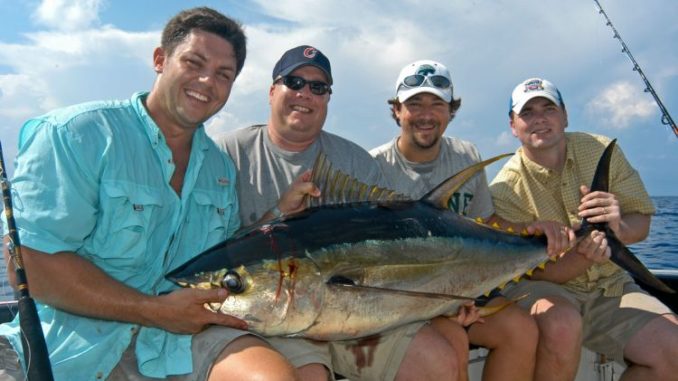
Although inshore guide Capt. Cody Obiol prefers engaging mullet from their schools’ perimeters, he has on occasion put a few live ones into service when calm seas allow a nearshore tuna run.
It’s simple fishing with potentially jaw-dropping results.
“You just hook a live mullet through the lips with a circle hook, let him swim around on top and the tuna just tear wear him out,” Obiol said.
Culling shrimpers offer another option. Separating tuna from their sensory magnets is tough, but diligent use of fresh mullet can work wonders.
“You cut the mullet up for chum, and then you put a chunk on your hook and let it fall into the chum line, and they’ll come up and eat it,” he said. “You’re just trying to pull those tuna off the back of that trawl boat.
“You keep your chum line going and they’ll stay there with you.
Simply chunking mullet down the backbone works, but you’ll get more use per fish with this chunking technique:
• Cut diagonal slices along the flank from gills to tail.
• Reverse your blade angle and cut another set of diagonal slices to form a cross hatch pattern.
• Lay your knife flat at the mullet’s tail and slice forward, along the spine, to release symmetrical chunks that are ideal for chum and bait.
Capt. Wade Wells of the Mexican Gulf Fishing Company cast-nets mullet of various sizes inside the passes and hauls them offshore for various uses.
He’ll rig finger mullet on 6/0 to 8/0 Mustad Demon circle hooks (39950NP-BN) for snapper, while larger mullet make dandy swordfish baits when fished on 9/0 to 10/0 Mustad 7691DT knife-edge hooks with hefty weights along the edge of the shelf.
Elsewhere, the mullet run does not go unnoticed by some of the Gulf’s most vicious predators.
“When the mullet go offshore to spawn, the king mackerel and wahoo get after them as soon as they start their journey out of the passes and bays,” Southern Kingfish Association Hall of Famer Marcus Kennedy said. “There are several salt domes offshore in 200 to 400 feet (of water) where the mullet and pogies congregate to spawn from November through March.
“During this time, every king and wahoo in the Northern Gulf will either be with the mullet and pogy schools in open water or congregated with them on the salt domes.”
Slow-trolling live mullet on stout wire stinger rigs or dropping them deep on downriggers is a good bet for tempting big, toothy predators.
On blustery days, pop out a kite and hang a live, bridled mullet just below the surface, where frantic splashing will bring hungry tyrants charging forth with bad intentions.
